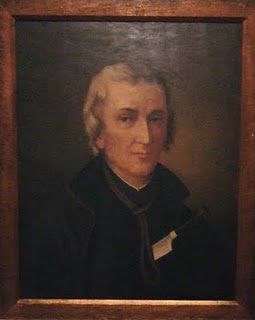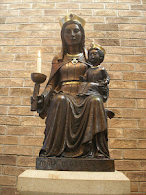The word “relic” comes from the Latin “reliquiae” and it means “remains”.
Saint Jerome said, “We do not worship, we do not adore, for fear that we should bow down to the creature rather than to the creator, but we venerate the relics of the martyrs in order the better to adore Him whose martyrs they are.”
In August 1679, at the
 execution of the Welsh Jesuit Martyr, Fr David Lewis, many Catholics were busy dipping cloths in the martyr’s blood. Within a short time of the martyrdom, cures were reported in Monmouthshire. These cures were attributed to the effectiveness of relics of the martyred priest.
execution of the Welsh Jesuit Martyr, Fr David Lewis, many Catholics were busy dipping cloths in the martyr’s blood. Within a short time of the martyrdom, cures were reported in Monmouthshire. These cures were attributed to the effectiveness of relics of the martyred priest.There are many known relics of St David Lewis still in existence. At Stonyhurst, there are several small unidentified relics of David Lewis. A small travelling chalice owned by St David Lewis is kept at the Catholic Church in Abergavenny, the saint’s birthplace.
Pieces of the rope with which Fr David Lewis was hanged are in the possession of several churches in this country. The Jesuit house in Farm Street, London, is said to have two pieces, a church at Roehampton has a piece and the Church of St David Lewis and St Francis Xavier, Usk, also has a piece.
The most numerous relics of St David Lewis seem to be cloths stained with his blood. Erdington Abbey has large pieces of linen soaked in his blood. The Church at Usk, as well as its fragment of rope, has a piece of linen stained with his blood. The Carmelite Convent at Lanherne, Cornwall, has a piece of blood stained linen. The Sisters of St Joseph of Annecy at Llantarnam Abbey also treasure a piece of linen stained with the blood of the martyr.
At one time, when Llantarnam Abbey was a private house, it was owned by Lady Frances Morgan, an aunt of Fr David Lewis. For a time, the priest lived with his relatives and regularly said Mass in the chapel there. The spot where he was arrested is opposite the Abbey. The Catholic Church of St David Lewis and St Francis Xavier, Usk, is either on or directly opposite the site of the martyrdom of St David Lewis. It seems appropriate then that relics of St David Lewis are in the safe keeping of the Catholic Church in Usk and Llantarnam Abbey in Cwmbran.









.JPG)

.JPG)






BG, thank you for sharing a new English martyr with us! Is that your relic?
ReplyDeleteGood Morning Esther
ReplyDeleteIt's nice to hear from you. My purpose in doing this blog is to let the world know about our wonderful Welsh (not English!) martyr. He is a great saint but, unfortunately, he is little known outside his own area. I am pleased that you have discovered him and my earliest posts give all kinds of details about St David Lewis, his life, work, family, etc. I would be very grateful, as well as delighted, if you could give him a mention in your wonderful blog. The relic? No, I am not fortunate enough to have a relic of St David Lewis. This one, photographed by my husband, belongs to the Sisters at Llantarnam Abbey, which is close to where we live. Thanks for everything, Esther, and God bless you.
Are the relics in a RC church....so called Llantarnam Abbey?
ReplyDeleteI'm very interested in visiting new places where I could find the tomb or relics from English saints, but I don't understand why every place I've gone there are no remains of the saints. I suppose It might be because of the Anglican Reform. Anyway It is so weird not to understand where the remains are.
Good Morning Ms Nicole J
ReplyDeleteThank you for visiting this blog. You can visit the grave of St David Lewis at the Priory Church of St Mary, Usk. It is the grave nearest to the main entrance of the church. Every year on the Sunday nearest to 27th August there is a pilgrimage to this holy site. One reason why there are no remains of many of the martyrs is that they were hanged, disemboweled, beheaded and quartered. The quarters were then distributed to various locations to be displayed prominently as a deterrent to others who clung to the Old Faith. Sometimes, as in the case of St David Lewis, the martyr was permitted a burial. I hope this helps answer your query somewhat. Thanks for taking the time to comment.